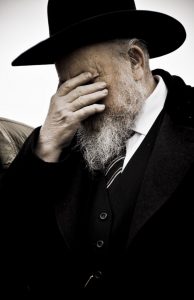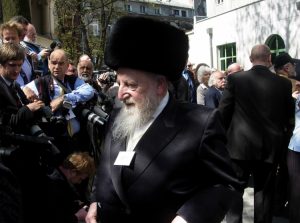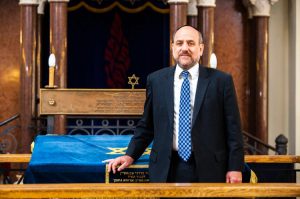
It was 1974 when Rabbi Edgar Gluck got the phone call that would forever change his life.
Warsaw’s Jewish community was in desperate need of a baal tefillah for the Yamim Nora’im after the person who normally davened for the amud suffered a heart attack. The caller was hoping that Rabbi Gluck would be willing to fly to Poland and serve as the chazzan for the High Holiday season.
Already involved in the preservation of Jewish cemeteries in Eastern Europe, the then 38- year- old Rabbi Gluck agreed to travel to Warsaw, spending Aseres Yemei Teshuvah visiting local cemeteries. He returned to Warsaw for the next two years as the baal tefillah, but by the time the next Rosh Hashanah rolled around it was Krakow, not Warsaw, who needed a chazzan. Rabbi Gluck agreed to make the trip, not realizing just how firmly entrenched he was going to become in modern-day Poland, or that one day he would be appointed as chief rabbi of Galicia, an area that encompasses parts of Poland, Hungary, Austria and the Ukraine.
The Poland That Was
For many, particularly those of us whose parents or grandparents hail from Poland, the country is frozen in time, at least in our minds. My father’s hometown of Bedzin was invaded by the Germans just days after the Nazis stormed Poland, and he has told us stories of a city that was and most likely never will be again. Described in a Haaretz article as “the Jerusalem” of southwestern Poland, Bedzin’s vibrant Jewish community dated back to the 16th century and by the time World War II broke out, approximately half of the city’s population of 60,000 was Jewish. My father remembers Bedzin’s landmark Great Synagogue as larger than any shul he has ever seen, with magnificent woodwork that was beyond compare. Summer Shabbosim would see community members taking advantage of the local eruv by bringing their cholents to cook in the bakery and later to be carried home by children who held the ends of towels looped through the ears of the heavy pots.
Growing up all those years as I did in the shadow of “the war,” I couldn’t visualize what Bedzin had looked like, other than hearing that a visit to Meah Shearim had sparked echoes of his hometown in my father’s mind. Two years ago the proverbial light bulb went off in my head. On a visit with my parents, I brought up Google Maps on my iPad and asked my father to name the street where he had lived, and sure enough, it was still there. There was Bedzin’s famous castle dating back to the 1300s and the river where my father had ice skated in the cold winter months. Scrolling down the street, Stanislawa Malachowskiego, my father was unable to pinpoint his house, but he recognized the landmarks – the hospital across the street, and the park. The commonalities to Meah Shearim that my father had noted were obvious, with residential apartments stacked atop storefronts in three and four story buildings. Some clearly showed their age, but others, like the one my father had lived in, had been recently redone.
Much of the magnificence my father recalled, however, was gone. By the time the war ended, the face of Poland had been horribly and savagely altered. 90 percent of the country’s Jews were gone, most of them murdered, and the remaining 35,000 Jews knew one truth: if you want to stay alive in communist Poland, don’t ever reveal the secret of your heritage. Fast forward multiple decades and the vast majority of the new generations born to those who stayed in Poland are living in a country that is a treasure trove of Jewish history.
Most have no idea that they are even Jewish.

Jewish Life’s Slow Return to Poland
Having spent time visiting cemeteries and shuls throughout Poland during his visits abroad, Rabbi Gluck’s efforts to restore holy sites gained considerable traction in 1987 when he was appointed by President Ronald Reagan to the United States Commission for the Preservation of America’s Heritage Abroad, a position he ultimately held for 28 years.
“I would go six or seven times a year, usually for two Shabbosim,” Rabbi Gluck told The Jewish Echo. “I would do whatever had to be done for the Jewish community. People in Brooklyn would ask me to go check on relatives’ graves in Poland. I would visit cemeteries, and Polish people would come to me with all kinds of questions. People asked me why I still go there and I’d tell them that I go because they need me and I can accomplish things there.”
Rabbi Michael Shudrich first traveled to Poland in 1973. Having just finished high school, he began traveling through Eastern Europe to see what was left of its once flourishing Jewish population. By 1979, he’d met several young Polish citizens who had discovered their Jewish roots, but they were in the minority.
“From 1939 to 1989 you didn’t tell anyone you were Jewish,” said Rabbi Shudrich. “Only after the fall of communism did people feel safe telling their children or their neighbors that they were Jewish and since that time, thousands have discovered that they have Jewish roots.”
In some cases, Polish citizens only learned of their Jewish identities through deathbed confessions of their parents or grandparents. Others discovered their religious roots when they began to question why they had no grandparents or other elderly relatives. In an interview with the Jerusalem Center for Public Affairs, Rabbi Shudrich said that since Poland became a democratic country, thousands of Polish citizens have found out for the first time that they were Jewish.
“They came in two broad categories: those who truly did not know and those who knew but considered it a subject one does not talk about in polite company,” said Rabbi Shudrich. “What is common to the two categories is that those born after 1938 had no Jewish education whatsoever.”
Rabbi Shudrich has been working in Poland on behalf of the Ronald S. Lauder Foundation since 1990, becoming the chief rabbi of both Warsaw and Lodz in 2000 and chief rabbi of Poland in 2004. Both Rabbi Gluck and Rabbi Shudrich say that modern-day Poland is far less anti-Semitic than outsiders realize.
“What changed things and has had the biggest impact on Poles’ attitudes to Jews was Pope John Paul II who said that anti-Semitism was a sin and if you want to understand Catholicism, you really need to understand Judaism. That changed the relationship of Catholics to Jews,” said Rabbi Shudrich.
“Things are definitely better there than it was or at least it is not as overt,” added Rabbi Gluck.
Rabbi Gluck, who maintains an apartment in Krakow, said that he has no qualms about walking through Krakow in his spodek.
“I once was walking down the street, and three guys ran by and shouted ‘Heil Hitler,’” recalled Rabbi Gluck. “15 minutes later I saw them again, this time in handcuffs. A police officer told me he had been assigned to watch me and that those three wouldn’t be coming back anytime soon.”
Did he have any idea that someone had been assigned to look out for him?
“Absolutely not,” admitted Rabbi Gluck.
History Continues to Unfold
Much has happened in Poland over the last ten years from a Jewish perspective.
It was a visit on behalf of someone he knew from Brooklyn, approximately a decade ago, that led Rabbi Gluck to a mass grave in Lubaczow, located in southeastern Poland near the Ukrainian border. Arriving in town, Rabbi Gluck sought out the director of the town’s museum hoping to get the key to the Jewish cemetery where his friend’s relatives were buried.
“He said to me ‘Why do you want to go the cemetery? Go to where they killed the Jews,’” recalled Rabbi Gluck.
The two men traveled approximately two miles to a field that Rabbi Gluck estimated to be the size of three football fields. The museum director told Rabbi Gluck that 2,500 Jews had been brought there and killed. Using his networking and persuasive skills, Rabbi Gluck found several people who said they had witnessed the carnage that took place on January 7, 1943.
“One guy told me ‘I was paving the highway there, it was the day after Christmas,’” said Rabbi Gluck. “Another guy said that the Nazis told him that if he ever told anyone what he saw they would shoot him. He and his wife stayed inside for an entire week because they were afraid to go outside.”
Using special equipment, Rabbi Gluck marked off the dimensions of the mass grave, and then got to work acquiring the property which was owned by the church but was about to be sold.
“They were planning on putting down a foundation for either a Waldorf Astoria or a shopping center in 90 days,” said Rabbi Gluck.
One week later, Rabbi Gluck was among several high ranking officials who had an audience with Pope Benedict on a papal visit to Auschwitz. While most of the dignitaries spoke with the Pope for just a few seconds, Rabbi Gluck’s time with him was considerably longer. Refusing to share details of that conversation with the media, Rabbi Gluck traded that information instead with a priest in exchange for the rights to the Lubaczow property, which he then had covered with seven layers of tar and surrounded by boulders to preserve the mass grave. A monument was erected at the site in May 2008, with prominent Polish officials and religious leaders attending a memorial service to honor those who were murdered there.
Over the years, Rabbi Gluck has been approached by Poles who want to share information with him, which has led to the discovery of other gravesites.
“People come and they tell me stories,” said Rabbi Gluck. “Years ago, if I asked people if they were Jewish they ran away, but now I have people coming to me and saying ‘I think I am Jewish.’”
Most of the people who speak with Rabbi Gluck are well into their nineties. Most are Jewish.
“The Polish gentiles don’t want to talk and find out their house really belongs to Moisha,” observed Rabbi Gluck. “I did have one lady who saved four girls and now those four girls have close to a thousand children and grandchildren and great-grandchildren.”
Of the seven shuls today in Krakow, four are now museums while the rest are used for davening. There are less than ten Orthodox rabbis in Poland; of those two are Chabad shluchim and two are Polish-born, one of whom discovered his Jewish identity at age 16. Six or seven Polish cities have shuls with weekly Shabbos davening and Lodz is trying hard to establish a daily minyan. Warsaw has daily minyanim, a Jewish school, and a kollel. In addition to reliable caterers supplying kosher food in Poland, the country has become a major exporter of kosher meat to Israel and France.

Poland Today
A massive rally held on Poland’s 99th independence day this past November 11 turned ugly, attracting the alt-right and demonstrators carrying signs bearing the words “ white Europe” and “pure blood” as reported by the Associated Press.
President Andrzej Duda condemned the march within days, as did the country’s minister of culture and the foreign ministry. The rally’s organizers, a group called All Polish Youth, have been banned from next year’s centennial independence day celebration, a response that Rabbi Shudrich deemed appropriate.
“Am I safe walking in the streets here?” asked Rabbi Shudrich. “Yes. Would it have been smart to walk out into the middle of that demonstration? Probably not.”
Poland has also found itself in the media spotlight with legislation recently proposed that would make it very difficult for survivors and their heirs to reclaim property that had been seized during World War II.
“Cases involving communal property, such as shuls, mikvaos and cemeteries have been slowly adjudicated since 1997,” explained Rabbi Shudrich. “When it came to private property there had been no laws on the books, so they tried passing an umbrella law, but the people who drafted the law were ignorant of the unique Jewish experience.”
If passed as is, the law would only help those who remained in Poland after the war reclaim their property. Rabbi Shudrich said that meetings are being held to discuss the modification of the proposed legislation.
“It is an open discussion, with no promises yet, but my sense is that they didn’t really understand at the beginning why what they were doing was problematic,” said Rabbi Shudrich.
Hope for the Future?
The mission to preserve Polish cemeteries and other holy sites is continuing and President Trump recently tapped an Orthodox Jewish Five Towns resident to head up the United States Commission for the Preservation of America’s Heritage Abroad. Rabbi Shudrich admitted that it is impossible to preserve all of the more than 1,000 Jewish cemeteries in Poland and that right now his goal is preventing their desecration, a growing concern as development spreads and unused land rises in value. He declined to project his vision for what Poland’s Jewish community could look like in ten years, instead choosing to reflect on the strides that have been taken over the last decade.
“There are no frum from birth people in Poland today, but religious observance is definitely growing in Poland,” said Rabbi Shudrich. “Someone who discovered he was Jewish five years ago and has taken on himself not to eat pork may not be considered a chozer b’teshuva, but he is still making a tremendous statement. I have seen a lot of resurgence over the past ten years, and I continue to be hopeful for the future.”
The links to Poland’s rich heritage stretch far and wide, noted Rabbi Shudrich.
“No matter how you live your Judaism, it was likely created in Poland and flourished there,” said Rabbi Shudrich. “If you are a Zionist, it comes from Poland. Agudas Yisroel comes from Poland. The Rama came from Poland. Daf Yomi started in Lublin, in Poland. The list just goes on and on.”
While the vast majority of Poland’s Jews fled the country without looking back, among those who remained are some whose roots are deeply entrenched in the tapestry of our own lives, making Jewish life in Poland a project whose efforts can potentially bear significant fruits.
“We have someone here who is a Kaminetzky,” said Rabbi Shudrich. “About three years ago we buried Rachel Hutner, the sister of the Pachad Yitzchak. Right now we have a unique opportunity to give back to the children and grandchildren and great-grandchildren of people who created Yiddishkeit and the way we live it today.”
Sandy Eller is a freelance writer who writes for numerous websites, newspapers, magazines and many private clients. She can be contacted at sandyeller1@gmail.com.
You must be logged in to post a comment.